Characteristic features, Functions, Types, Modification of Stem - Shoot system (Stem) | 11th Botany : Chapter 3 : Vegetative Morphology of Angiosperm
Chapter: 11th Botany : Chapter 3 : Vegetative Morphology of Angiosperm
Shoot system (Stem)
The plumule of the embryo of a germinating seed
grows into stem. The epicotyl elongates after embryo growth into the axis (the
stem) that bears leaves from its tip, which contain the actively dividing cells
of the shoot called apical meristem. Further cell divisions and growth result in the formation of mass
of tissue called a leaf primordium.
The point from which the leaf arises is called node. The region between two adjacent nodes is called internode.
I. Characteristic features of the stem
1. The stem is usually the aerial portion of the
plant
2. It is positively phototropic and negatively
geotropic
3. It has nodes and internodes.
4. Stem bears vegetative bud for vegetative growth
of the plant, and floral buds for reproduction, and ends in a terminal bud.
5. The young stem is green and thus carries out
photosynthesis.
6. During reproductive growth stem bears flowers
and fruits.
7. Branches arise exogenously
8. Some stems bears multicellular hairs of
different kinds.
II. Functions of the stem
Primary functions
1. Provides support and bears leaves, flowers and
fruits.
2. It transports water and mineral nutrients to the
other parts from the root.
3. It transports food prepared by leaves to other parts
of the plant body.
Secondary functions
•
Food
storage- Example: Solanum tuberosum, Colocasia and Zingiber officinale
•
Perennation
/ reproduction – Example: Zingiber officinale, Curcuma longa
•
Water
storage – Example: Opuntia
•
Bouyancy –
Example: Neptunia
•
Photosynthesis
–
Example: Opuntia, Ruscus, Casuarina,
Euphorbia, Caralluma.
•
Protection
–
Example: Citrus, Duranta, Bougainvillea, Acacia, Fluggea, Carissa.
•
Support - Example: Passiflora,
Bougainvillea, Vitis, Cissus quadrangularis.
1. Buds
Buds are the growing points surrounded by
protective scale leaves. The bud primordium matures into bud. They have
compressed axis in which the internodes are not elongated and the young leaves
are closed and crowded. When these buds develop, the internodes elongate and
the leaves spread out. Buds have architecture identical to the original shoot
and develop into lateral branches or may terminate by developing into a flower
or inflorescence. Based on Origin Buds are classified into (a) Terminal or
Apical bud (b) Lateral or Axillary or Axil bud. Based on Function Buds
classified into (a) Vegetative bud (b) Floral or Reproductive bud
1.
Terminal
bud or apical bud: These buds
are present at the apex of the main stem and at the tips of the branches.
2.
Lateral
bud or Axillary bud: These buds
occur in the axil of the leaves and develop into a branch or flower.
2.
Extra
axillary bud : These buds are
formed at nodes but outside the axil of the leaf as in Solanum americanum.
3.
Accessory
bud : An extra bud on either side
(collateral bud) or above (superposed bud or serial bud) the axillary bud.
Example: Citrus and Duranta
4.
Adventitious
buds: Buds arising at any part
other than stem are known as adventitious
bud. Radical buds are those that arises from the lateral roots which grow
into plantlets. Example: Millingtonia,
Bergera koenigii (Murraya koenigii),
Coffea arabica and Aegle marmelos. Foliar buds
are those that grow on leaves from
veins or from margins of the leaves. Example: Begonia (Elephant ear plant) and Bryophyllum (Sprout leaf plant). Cauline buds arise directly from the stem either from cut, pruned
ends or from branches. Adventitious buds function as propagules which are
produced on the stem as tuberous structures. Example: Dioscorea, Agave.
5.
Bulbils (or specialized buds) : Bulbils are
modified and enlarged bud, meant for propagation. When bulbils detach from
parent plant and fall on the ground, they germinate into new plants and serve
as a means of vegetative propagation.
In Agave and Allium proliferum floral buds get modified into bulbils. In Lilium bulbiferum and Dioscorea
bulbifera, the bulbils develop in axil of leaves. In Oxalis, they develop just above the swollen root.
2. Types of Stem
Majority of angiosperm possess upright, vertically
growing erect stem. They are (i) Excurrent, (ii) Decurrent, (iii) Caudex,
(iv) Culm.
i. Excurrent
The main axis shows continuous growth and the
lateral branches gradually becoming shorter towards the apex which gives a
conical appearance to the trees. Example: Polyalthia
longifolia, Casuarina.
ii. Decurrent
The growth of lateral branch is more vigorous than
that of main axis. The tree has a rounded or spreading appearance. Example: Mangifera indica, Azadirachta indica, Tamarindus indicus, Aegle marmelos
iii. Caudex
It’s an unbranched, stout, cylindrical stem, marked
with scars of fallen leaves. Example: Cocus
nucifera, Borassus flabelliformis,
Areca catechu
iv. Culm
Erect stems with distinct nodes and usually hollow
internodes clasped by leaf sheaths. Example: Majority of grasses including
Bamboo.
3. Modification of Stem
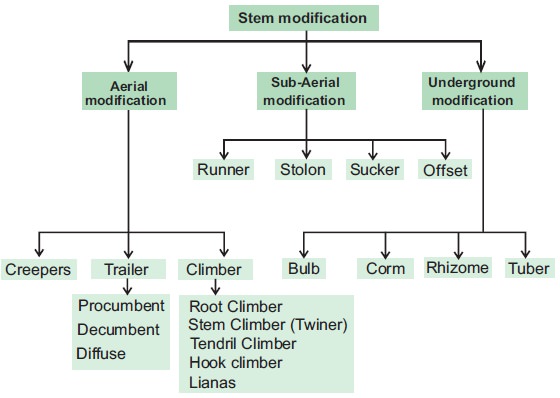
I. Aerial modification of stem
1. Creepers
These are plants growing closer (horizontally) to the
ground and produces roots at each node. Example: Cynodon dactylon, Oxalis,
Centella
2. Trailers (Stragglers)
It is a weak stem that spreads over the surface of
the ground without rooting at nodes. They are divided into 3 types,
i.
Prostrate
(Procumbent): A stem that grows
flat on the ground. Example: Evolvulus
alsinoides, Indigofera prostrata.
ii.
Decumbent:
A stem
that grows flat but becomes erect
during reproductive stage. Example: Portulaca,
Tridax, Lindenbergia
iii.
Diffuse: Atrailingstemwithspreading
branches. Example: Boerhaavia diffusa, Merremia tridentata
3. Climbers
These plants have long weak stem and produce
special organs for attachment for climbing over a support. Climbing helps to
display the leaves towards sunlight and to position the flower for effective
pollination.
i. Root climbers
Plants climbing with the help of adventitious roots
(arise from nodes) as in species of Piper
betel, Piper nigrum, Hedera helix,
Pothos, Hoya.
ii. Stem climbers (twiners)
These climbers lack specialised structure for
climbing and the stem itself coils around the support. Example: Ipomoea, Convolvulus, Dolichos, Clitoria, Quisqualis.
Stem climbers may coil around the support clockwise or anti-clockwise. Clockwise coiling climbers are called dextrose. Example: Dioscorea alata. Anti-clockwise coiling climbers are called sinistrose. Example: Dioscorea bulbifera.
iii. Hook climbers
These plants produce specialized hook like
structures which are the modification of various organs of the plant. In Artabotrys inflorescence axis is
modified into hook. In calamus (curved hook) leaf tip is
modified into hook. In Bignonia unguis- cati the leaflets are modified
into curved hook (figure: 3.17). In Hugonia the axillary buds modified into
hook.
iv. Thorn climbers
Climbing or reclining on the support with the help
of thorns as in Bougainvillea and Carissa.
v. Lianas (woody stem climber)
Woody perennial climbers found in tropical forests
are lianas. They twine themselves around tall trees to get light. Example: Hiptage
benghalensis, Bauhinia vahlii, Entada pursaetha.
vi. Tendril climbers
Tendrils are thread-like coiling structures which
help the plants in climbing. Tendrils may be modifications of Stem – as in Passiflora, Vitis and Cissus
quadrangularis; Inflorescence axis – Antigonon;
Leaf – Lathyrus; Leaflets - Pisum sativum; Petiole – Clematis; Leaftip – Gloriosa; Stipules – Smilax. In pitcher plant (Nepenthes) the midrib of the leaf often coils around a support like a tendril and
holds the pitcher in a vertical position.
Phylloclade
This is a green, flattened cylindrical or angled
stem or branch of unlimited growth, consisting of a series of nodes and
internodes at long or short intervals. Phylloclade is characteristic adaptation
of xerophytes where the leaves often fall off early and modified into spines or
scales to reduce transpiration. The phylloclade takes over all the functions of
leaves, particularly photosynthesis. The phylloclade is also called as cladophyll.
Example: Opuntia,
Phyllocactus, Muehlenbeckia (flattened
phylloclade) Casuarina, Euphorbia
tirucalli, Euphorbia antiquorum (cylindrical phylloclade).
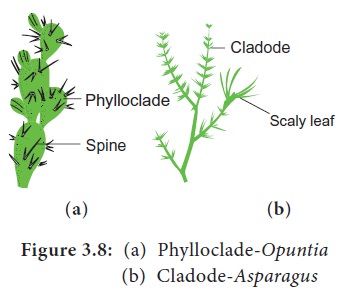
Cladode
Cladode is a flattened or cylindrical stem similar
to Phylloclade but with one or two internodes only. Their stem nature is
evident by the fact that they bear buds, scales and flowers. Example: Asparagus (cylindrical cladode), Ruscus (flattened Cladode).
Thorns
Thorn is a woody and sharp pointed modified stem.
Either the axillary bud or the terminal bud gets modified into thorns. In Carissa apical bud modified into thorns.
In Citrus and Atalantia axillary bud is modified into thorns.
II. Sub aerial stem modifications
Sub aerial stem found in plants with weak stem in
which branches lie horizontally on the ground. These are meant for vegetative
propagation. They may be sub aerial or partially sub terranean.
1. Runner
This is a slender, prostrate branch creeping on the
ground and rooting at the nodes. Example: Centella
(Indian pennywort), Oxalis (wood
sorrel), lawn grass (Cynodon dactylon).
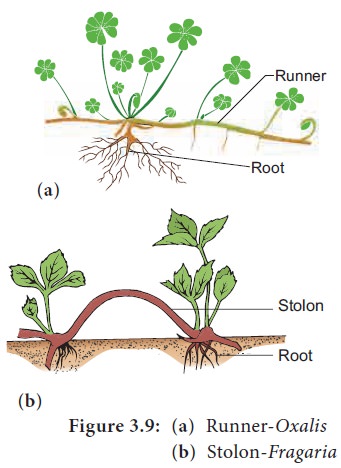
2. Stolon
This is also a slender, lateral branch originating
from the base of the stem. But it first grows obliquely above the ground,
produces a loop and bends down towards the ground. When touches the ground it
produces roots and becomes an independent plantlet. Example: Mentha piperita (peppermint),
Fragaria indica (wild strawberry).
3. Sucker
Sucker develops from a underground stem and grows
obliquely upwards and gives rise to a separate plantlet or new plant. Example: Chrysanthemum, Musa, Bambusa.
4. Offset
Offset is similar to runner but found in aquatic
plants especially in rosette leaved forms. A short thick lateral branch arises
from the lower axil and grows horizontally leafless for a short distance, then
it produces a bunch of rosette leaves and root at nodes. Example: Eichhornia (water hyacinth), Pistia (water lettuce).
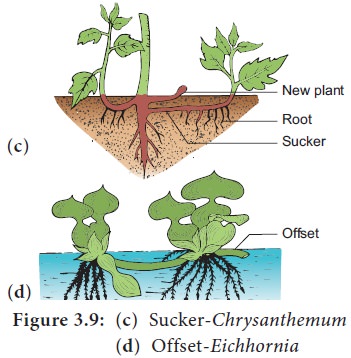
III. Underground stem modifications
Perennial and some biennial herbs have underground
stems, which are generally known as root
stocks. Rootstock functions as a storage and protective organ. It remains
alive below the ground during unfavourable conditions and resumes growth during
the favourable conditions.
Underground stems are not roots because they
possess nodes, internodes, scale-leaves and buds. Rootstock also lack root cap
and root hairs but they possess terminal bud which is a characteristics of stem.
1. Bulb
It is a condensed conical or convex stem surrounded
by fleshy scale leaves. They are of two types 1. Tunicated (coated) bulb: In
which the stem is much condensed and surrounded by several concentric layers of
scale leaves. The inner scales commonly fleshy, the outer ones dry. These are
two types (a) Simple Tunicated bulb Example: Allium cepa (b) Compound Tunicated bulb. Example: Allium
sativum. 2. Scaly bulb: They are narrow, partially overlap each other by
their margins only. Example:![]()
![]()
![]() Tulipa spp.
Tulipa spp.
Pseudobulb is a short erect aerial storage or
propagating stem of certain epiphytic and terrestrial sympodial orchids.
Example: Bulbophyllum.
2. Corm
This is a succulent underground stem with an erect growing tip. The corm is surrounded by scale leaves and exhibit nodes and internodes. Example: Amorphophallus, Gladiolus, Colocasia, Crocus, Colchicum
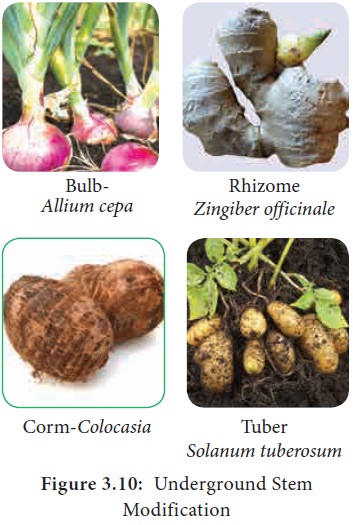
3. Rhizome
This is an underground stem growing horizontally
with several lateral growing tips. Rhizome posses conspiquous nodes and
internodes covered by scale leaves. Example: Zingiber officinale, Canna, Curcuma
longa, Maranta arundinacea, Nymphaea, Nelumbo.
4. Tuber
This is a succulent underground spherical or
globose stem with many embedded axillary buds called “eyes”. Example: Solanum
tuberosum, Helianthus tuberosus
IV. Stem Branching
Branching pattern is determined by the relative
activity of apical meristems. The mode of arrangement of branches on a stem is
known as branching. There are two
main types of branching, 1. Lateral branching and 2. Dichotomous branching.
Based on growth pattern stems may show indeterminate or determinate growth.
(a) Indeterminate: The terminal bud grows uninterrupted and produce
several lateral branches. This type of growth is also known as monopodial branching. Example: Polyalthia, Swietenia, Antiaris.
(b) Determinate: The terminal bud caese to grow after a period of growth and
the further growth is taken care by successive or several lateral meristem or
buds. This type of growth is also known as sympodial
branching. Example: Cycas.
Related Topics